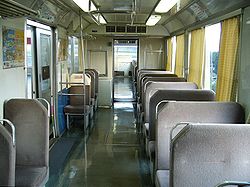
Peachliner
Encyclopedia


People mover
A people mover or automated people mover is a fully automated, grade-separated mass transit system.The term is generally used only to describe systems serving relatively small areas such as airports, downtown districts or theme parks, but is sometimes applied to considerably more complex automated...
in the city of Komaki
Komaki, Aichi
is a city located in Aichi, Japan. It is commonly associated with the former Nagoya Airport, which is partly located in the city. The other part is in the city of Kasugai. As of January 1, 2008, the city has an estimated population of 149,060 and the density of 2,370 persons per km²...
, Aichi Prefecture
Aichi Prefecture
is a prefecture of Japan located in the Chūbu region. The region of Aichi is also known as the Tōkai region. The capital is Nagoya. It is the focus of the Chūkyō Metropolitan Area.- History :...
, Japan
Japan
Japan is an island nation in East Asia. Located in the Pacific Ocean, it lies to the east of the Sea of Japan, China, North Korea, South Korea and Russia, stretching from the Sea of Okhotsk in the north to the East China Sea and Taiwan in the south...
. It operated from 1991 until September 30, 2006, when it became the first people-mover system in Japan to cease operations.
History
The planning of the line started in 1971 along with the planning of Tōkadai New Town, a planned cityNew town
A new town is a specific type of a planned community, or planned city, that was carefully planned from its inception and is typically constructed in a previously undeveloped area. This contrasts with settlements that evolve in a more ad hoc fashion. Land use conflicts are uncommon in new...
outside Komaki designed for 54,000 people. The decision to choose a people mover system was made in 1974, with a projected ridership of 43,000 passengers per day (ppd) and a budget of 24.5 billion yen, and a second stage to Kōzōji planned. However, in 1978, the town's planned size was cut down to 47,000 people and the ridership estimate was cut to 23,000 ppd. Construction started in 1981 based on this estimate.
In 1984, the town's design was again downsized to 40,000 people and the ridership to 20,000 ppd. A decision was also made to operate the line manually instead of in fully automated mode. The line was opened on March 25, 1991, charging ¥300 for an end-to-end trip, but by this time the ridership projection had been cut to just 12,000 passengers per day.
However, between 1991 and 2004 the line only averaged 2,670 passengers per day, amounting to only 6% of the original estimate and 22% of the opening-day projection. The maintenance of the line required some 11.5 billion yen per year, a tenth of Tokadai New Town's budget and, compared to construction costs of 31.3 billion yen, the equivalent of rebuilding the line from scratch every three years. According to calculations by the local chapter of the Japanese Communist Party
Japanese Communist Party
The Japanese Communist Party is a left-wing political party in Japan.The JCP advocates the establishment of a society based on socialism, democracy and peace, and opposition to militarism...
(disputed by some town councillors), the building of the line had increased the original sale prices of apartments in the area by approximately one million yen.
In 2005, the option of converting the line to use Toyota's experimental IMTS
Guided bus
Guided buses are buses steered for part or all of their route by external means, usually on a dedicated track. This track, which often parallels existing roads, excludes other traffic, permitting the maintenance of reliable schedules on heavily used corridors even during rush hours.Guidance systems...
(guided bus) technology was considered, but this was rejected by Aichi Prefecture in November as too difficult and risky. The decision to close the line was made in December, and the line ceased operating on September 30, 2006.
Operator
The Peachliner was operated by Tōkadai Shin-kōtsūhttp://peachliner.jp/gaiyou.htm#gaiyo. Stock in this third-sector companyVoluntary sector
The voluntary sector or community sector is the sphere of social activity undertaken by organizations that are for non-profit and non-governmental. This sector is also called the third sector, in reference to the public sector and the private sector...
is held by Aichi Prefecture (46%), the city of Komaki (10%), Nagoya Railroad
Nagoya Railroad
, often abbreviated as , is a railroad company operating around Aichi Prefecture and Gifu Prefecture of Japan.Some of the more famous trains operated by Nagoya Railroad include the Panorama Car and the Panorama Car Super, both of which offer views through their wide front windows...
(10%), and others.
Data
- Length: 7.4 km
- Stations: 7
- Multiple-track: Entire line
- Electrification: 750 V
Stations
- Komaki Station
- Komakihara Station
- Higashi Tanaka Station
- Kamisue Station
- Tōkadai-nishi Station
- Tōkadai-center Station
- Tōkadai-higashi Station
Komaki and Komakihara Stations remain in service on the Nagoya Railroad
Nagoya Railroad
, often abbreviated as , is a railroad company operating around Aichi Prefecture and Gifu Prefecture of Japan.Some of the more famous trains operated by Nagoya Railroad include the Panorama Car and the Panorama Car Super, both of which offer views through their wide front windows...
(Meitetsu) Komaki Line.

